|
Tautavel Man
Tautavel Man refers to the archaic humans which—from approximately 550,000 to 400,000 years ago—inhabited the Caune de l’Arago, a limestone cave in Tautavel, France. They are generally grouped as part of a long and highly variable lineage of transitional morphs which inhabited the Middle Pleistocene of Europe, and would eventually evolve into the Neanderthals (''Homo neanderthalensis'' or ''H. sapiens neanderthalensis''). They have been variably assigned to either '' H. (s.?) heidelbergensis'', or as a European subspecies of ''H. erectus'' as ''H. e. tautavelensis''. The skull is reconstructed based on the specimens Arago 21 and 47 (probably male), and it is, to a degree, more characteristic of what might be considered a typical ''H. erectus'' (''sensu stricto'') morphology than a typical ''H. heidelbergensis'' morphology. The brain capacity is 1,166 cc. They seem to have had an overall robust skeleton. Average height may have been . The Caune de l'Arago opens on a cliffs ... [...More Info...] [...Related Items...] OR: [Wikipedia] [Google] [Baidu] |
Henry De Lumley
Henry de Lumley (born 1934 in Marseille) is a French archeologist, geologist and prehistorian. He is director of the Institute of Human Paleontology in Paris, and Professor Emeritus at the Museum of Natural History in Paris. He is also a corresponding member of the Academy of Humanities of the Institute of France and former director of the French National Museum of Natural History. He is best known for his work on archeological sites in France and Spain, notably Arago cave in Tautavel, Southern France, Terra Amata in Nice and Grotte du Lazaret near Nice, and Baume Bonne at Quinson, where some of the earliest evidence of man in Europe were found. Publications (in French) * 1957 - "''Les industrie à micro-lithes géométriques''" with Max Escalon de Fonton, in: ''Bull S.P.F.LIV n°3-4. * 1969 - "''Le Paléolithique inférieur et moyen du Midi méditerranéen dans son cadre géologique''", Ve supplément à Gallia préhistoire. * 1969 - "''Une cabane acheuléenne dans la Grott ... [...More Info...] [...Related Items...] OR: [Wikipedia] [Google] [Baidu] |
Fallow Deer
''Dama'' is a genus of deer in the subfamily Cervinae, commonly referred to as fallow deer. Name The name fallow is derived from the deer's pale brown colour. The Latin word ''dāma'' or ''damma'', used for roe deer, gazelles A gazelle is one of many antelope species in the genus ''Gazella'' . This article also deals with the seven species included in two further genera, '' Eudorcas'' and '' Nanger'', which were formerly considered subgenera of ''Gazella''. A thir ..., and antelopes, lies at the root of the modern scientific name, as well as the German ''Damhirsch'', French ''daim'', Dutch ''damhert'', and Italian ''daino''. In Croatian and Serbian, the name for the fallow deer is ''jelen lopatar'' ("shovel deer"), due to the form of its antlers. The Modern Hebrew name of the fallow deer is ''yachmur'' (יחמור). Taxonomy and evolution The genus includes two extant species: Extant species Some taxonomists include the Persian fallow deer as a subspecies (''D. ... [...More Info...] [...Related Items...] OR: [Wikipedia] [Google] [Baidu] |
Marcel De Serres
Marcel may refer to: People * Marcel (given name), people with the given name Marcel * Marcel (footballer, born August 1981), Marcel Silva Andrade, Brazilian midfielder * Marcel (footballer, born November 1981), Marcel Augusto Ortolan, Brazilian striker * Marcel (footballer, born 1983), Marcel Silva Cardoso, Brazilian left back * Marcel (footballer, born 1992), Marcel Henrique Garcia Alves Pereira, Brazilian midfielder * Marcel (singer), American country music singer * Étienne Marcel (died 1358), provost of merchants of Paris * Gabriel Marcel (1889–1973), French philosopher, Christian existentialist and playwright * Jean Marcel (died 1980), Madagascan Anglican bishop * Jean-Jacques Marcel (1931–2014), French football player * Rosie Marcel (born 1977), English actor * Sylvain Marcel (born 1974), Canadian actor * Terry Marcel (born 1942), British film director * Claude Marcel (1793-1876), French diplomat and applied linguist Other uses * Marcel (''Friends''), a fiction ... [...More Info...] [...Related Items...] OR: [Wikipedia] [Google] [Baidu] |
Cannibalism
Cannibalism is the act of consuming another individual of the same species as food. Cannibalism is a common ecological interaction in the animal kingdom and has been recorded in more than 1,500 species. Human cannibalism is well documented, both in ancient and in recent times. The rate of cannibalism increases in nutritionally poor environments as individuals turn to members of their own species as an additional food source.Elgar, M.A. & Crespi, B.J. (1992) ''Cannibalism: ecology and evolution among diverse taxa'', Oxford University Press, Oxford ngland New York. Cannibalism regulates population numbers, whereby resources such as food, shelter and territory become more readily available with the decrease of potential competition. Although it may benefit the individual, it has been shown that the presence of cannibalism decreases the expected survival rate of the whole population and increases the risk of consuming a relative. Other negative effects may include the increased r ... [...More Info...] [...Related Items...] OR: [Wikipedia] [Google] [Baidu] |
Biface
A hand axe (or handaxe or Acheulean hand axe) is a prehistoric stone tool with two faces that is the longest-used tool in human history, yet there is no academic consensus on what they were used for. It is made from stone, usually flint or chert that has been "reduced" and shaped from a larger piece by knapping, or hitting against another stone. They are characteristic of the lower Acheulean and middle Palaeolithic ( Mousterian) periods, roughly 1.6 million years ago to about 100,000 years ago, and used by '' Homo erectus'' and other early humans, but rarely by ''Homo sapiens''. Their technical name (biface) comes from the fact that the archetypical model is a generally bifacial (with two wide sides or faces) and almond-shaped (amygdaloidal) lithic flake. Hand axes tend to be symmetrical along their longitudinal axis and formed by pressure or percussion. The most common hand axes have a pointed end and rounded base, which gives them their characteristic almond shape, an ... [...More Info...] [...Related Items...] OR: [Wikipedia] [Google] [Baidu] |
Scraper (archaeology)
In prehistoric archaeology, scrapers are unifacial tools thought to have been used for hideworking and woodworking. Many lithic analysts maintain that the only true scrapers are defined on the base of use-wear, and usually are those that were worked on the distal ends of blades—i.e., " end scrapers" (french: grattoir, link=no). Other scrapers include the so-called " side scrapers" or racloirs, which are made on the longest side of a flake, and notched scrapers, which have a cleft on either side that may have been used to attach them to something else. Scrapers are typically formed by chipping the end of a flake of stone in order to create one sharp side and to keep the rest of the sides dull to facilitate grasping it. Most scrapers are either circle or blade-like in shape. The working edges of scrapers tend to be convex, and many have trimmed and dulled lateral edges to facilitate hafting. One important variety of scraper is the thumbnail scraper, a scraper shaped mu ... [...More Info...] [...Related Items...] OR: [Wikipedia] [Google] [Baidu] |
Retouched
Photograph manipulation involves the transformation or alteration of a photograph using various methods and techniques to achieve desired results. Some photograph manipulations are considered to be skillful artwork, while others are considered to be unethical practices, especially when used to deceive the public. Other examples include being used for political propaganda, or to improve the appearance of a product or person, or simply as entertainment or practical jokes. Depending on the application and intent, some photograph manipulations are considered an art form because it involves the creation of unique images and in some instances, signature expressions of art by photographic artists. Ansel Adams employed some of the more common manipulations using darkroom exposure techniques, burning (darkening) and dodging (lightening) a photograph. Other examples of photo manipulation include retouching photographs using ink or paint, airbrushing, double exposure, piecing photos ... [...More Info...] [...Related Items...] OR: [Wikipedia] [Google] [Baidu] |
Stone Tool
A stone tool is, in the most general sense, any tool made either partially or entirely out of stone. Although stone tool-dependent societies and cultures still exist today, most stone tools are associated with prehistoric (particularly Stone Age) cultures that have become extinct. Archaeology, Archaeologists often study such prehistoric societies, and refer to the study of stone tools as lithic analysis. Ethnoarchaeology has been a valuable research field in order to further the understanding and cultural implications of stone tool use and manufacture. Stone has been used to make a wide variety of different tools throughout history, including arrowheads, spearheads, hand axes, and Quern-stone, querns. Stone tools may be made of either ground stone or Lithic reduction, knapped stone, the latter fashioned by a flintknapper. Knapped stone tools are made from cryptocrystalline materials such as chert or flint, radiolarite, chalcedony, obsidian, basalt, and quartzite via a process ... [...More Info...] [...Related Items...] OR: [Wikipedia] [Google] [Baidu] |
Acheulean
Acheulean (; also Acheulian and Mode II), from the French ''acheuléen'' after the type site of Saint-Acheul, is an archaeological industry of stone tool manufacture characterized by the distinctive oval and pear-shaped " hand axes" associated with ''Homo erectus'' and derived species such as '' Homo heidelbergensis''. Acheulean tools were produced during the Lower Palaeolithic era across Africa and much of West Asia, South Asia, East Asia and Europe, and are typically found with ''Homo erectus'' remains. It is thought that Acheulean technologies first developed about 1.76 million years ago, derived from the more primitive Oldowan technology associated with ''Homo habilis''. The Acheulean includes at least the early part of the Middle Paleolithic. Its end is not well defined, depending on whether Sangoan (also known as "Epi-Acheulean") is included, it may be taken to last until as late as 130,000 years ago. In Europe and Western Asia, early Neanderthals adopted Acheul ... [...More Info...] [...Related Items...] OR: [Wikipedia] [Google] [Baidu] |
European Beaver
The Eurasian beaver (''Castor fiber'') or European beaver is a beaver species that was once widespread in Eurasia, but was hunted to near-extinction for both its fur and castoreum. At the turn of the 20th century, only about 1,200 beavers survived in eight relict populations in Europe and Asia. It has been reintroduced to much of its former range, and now occurs from Spain, Central Europe, Great Britain and Scandinavia to a few regions in China and Mongolia. It is listed as least concern on the IUCN Red List, as it recovered well in most of Europe. It is extirpated in Portugal, Moldova, and Turkey. Taxonomy ''Castor fiber'' was the scientific name used by Carl Linnaeus in 1758, who described the beaver in his work ''Systema Naturae''. Between 1792 and 1997, several Eurasian beaver zoological specimens were described and proposed as subspecies, including: *''C. f. albus'' and ''C. f. solitarius'' by Robert Kerr in 1792 *''C. f. fulvus'' and ''C. f. variegatus'' by Johann Ma ... [...More Info...] [...Related Items...] OR: [Wikipedia] [Google] [Baidu] |
Reindeer
Reindeer (in North American English, known as caribou if wild and ''reindeer'' if domesticated) are deer in the genus ''Rangifer''. For the last few decades, reindeer were assigned to one species, ''Rangifer tarandus'', with about 10 subspecies. A 2022 revision of the genus elevated five of the subspecies to species (see Taxonomy below). They have a circumpolar distribution and are native to the Arctic, sub-Arctic, tundra, boreal forest, and mountainous regions of northern Europe, Siberia, and North America. Reindeer occur in both migratory and sedentary populations, and their herd sizes vary greatly in different regions. The tundra subspecies are adapted for extreme cold, and some are adapted for long-distance migration. Reindeer vary greatly in size and color from the smallest species, the Svalbard reindeer (''R. t. platyrhynchus''), to the largest subspecies, Osborn's caribou (''R. t. osborni''). Although reindeer are quite numerous, some species and subspecies a ... [...More Info...] [...Related Items...] OR: [Wikipedia] [Google] [Baidu] |










